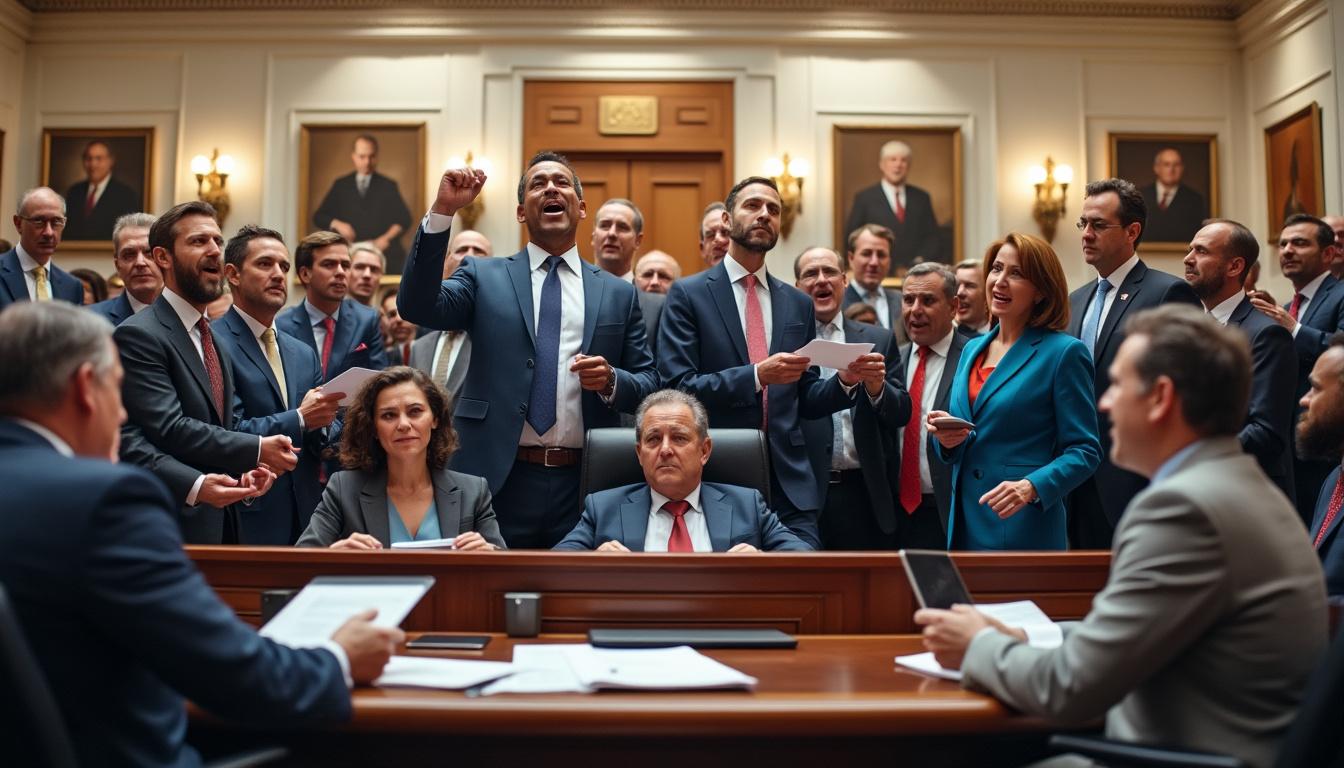The House of Representatives embarked on a historic journey that could redefine the United States’ regulatory landscape for cryptocurrencies. Following an intense two-day political showdown, a groundbreaking vote finally advanced a set of crucial crypto regulation bills, promising to bring unprecedented clarity and legal structure to a rapidly evolving digital asset sector. This move, occurring amid fierce ideological divisions within the Republican conference, interlaces complex negotiations, stakeholder pressures, and bipartisan cooperation. The implications of this vote ripple far beyond Capitol Hill, striking at the core of influential entities like Coinbase, Binance, Kraken, and Gemini, while directly impacting foundational innovations such as stablecoins, decentralized finance, and blockchain security protocols.
Analyzing The Impact of The House Vote on Crypto Regulation Frameworks
The recent vote in the House constitutes a seminal moment towards establishing a comprehensive governance framework for cryptocurrencies in the United States. The three bills at the center of this legislative push — the GENIUS Act, the CLARITY Act, and a bill targeting the prohibition of a Federal Reserve-led central bank digital currency (CBDC) — encapsulate distinct areas of regulatory concern. The GENIUS Act, which successfully passed the Senate in June, addresses stablecoins by setting standards to ensure their reliability and backing. The CLARITY Act aims to delineate clearer regulatory guidance for digital asset exchanges, including giants like Bitfinex, Ripple, and Bitstamp.
This legislative momentum, however, was hard-won. Resistance from conservative and moderate Republicans prompted a 10-hour voting deadlock, marking the longest open House vote in contemporary history. Speaker Mike Johnson’s leadership proved critical, navigating a volatile coalition where even minor Republican defections could derail the bill. The political complexity underscores the industry’s regulatory sensitivity and highlights the powerful lobbying efforts from crypto-centric entities, which collectively invested tens of millions during the last campaign cycle to influence outcomes.
Detailed Breakdown of the Legislative Battleground
- GENIUS Act: Establishes standards governing the issuance and reserve requirements of stablecoins, aiming to prevent systemic risks similar to traditional financial frauds.
- CLARITY Act: Provides a more explicit regulatory framework for crypto exchanges to operate transparently, impactfully affecting platforms such as Kraken, Gemini, and Coinbase.
- Anti-CBDC Bill: Seeks to restrict the Federal Reserve from launching its own digital currency, reflecting concerns over privacy and federal overreach.
The merger of two bills raised controversy, especially among Committee on Financial Services authors, who voiced opposition against last-minute amendments that blurred legislative intent. This internal dissent hints at ongoing challenges in reconciling regulatory clarity with industry innovation, signaling that while the vote was a critical step, much debate lies ahead as the bills progress towards final implementation.
| Bill | Main Focus | Statut actuel | Key Industry Stakeholders |
|---|---|---|---|
| GENIUS Act | Stablecoin oversight and guarantees | Passed Senate, advancing in House | Circle, Coinbase, Binance, Ripple |
| CLARITY Act | Exchange transparency and regulation | Under House debate with amendments | Kraken, Gemini, Bitfinex, Bitstamp |
| Anti-CBDC Bill | Prevent Federal Reserve digital currency | House deliberation stage | BlockFi, Polygon, Chainalysis |
Challenges and Political Dynamics Influencing Crypto Lawmaking
Among the most remarkable aspects of this legislative episode is the extent to which intra-party divergence shaped the regulatory trajectory. Conservative Republicans initially stalled the bills, citing concerns over federal overreach and the potential for excessive regulation to suffocate innovation in decentralized finance (DeFi). Conversely, moderate Republicans pushed back against amendments crafted to appease hardline conservatives, fearing they might undermine investor protections or market stability.
Former President Donald Trump’s intervention late on Tuesday exemplified the high-stakes political drama—the meeting in the Oval Office with a dozen conservative Republicans brought a temporary alignment, with Trump publicly declaring support through social media platforms like Truth Social. Nevertheless, new objections arose from lawmakers on key committees responsible for the legislation, slowing progress even after this high-profile involvement.
The tug of war reflects broader debates regarding the proper scope of regulation and the U.S. government’s role in an increasingly globalized crypto market. Industry leaders and legal experts alike anticipate that the current bills will heavily influence future policy, with echoes beyond U.S. borders in shaping global regulatory standards, as detailed in comparative analyses of worldwide cryptocurrency regulations.
List of Influences Shaping the Voting Outcome
- Conservative skepticism about federal digital currency and regulatory overreach.
- Moderate GOP concerns about last-minute bill modifications.
- Lobbying efforts by crypto industry giants and advocacy groups.
- Trump’s mediation to broker compromises with hardline conservatives.
- Committee authors’ pushback regarding legislative coherence and content.
| Influence Factor | Impact on Legislation | Resulting Effect |
|---|---|---|
| Conservative Republicans | Opposed initial vote, causing delays | Prolonged debate, demanded amendments |
| Moderate Republicans | Objected to compromises in bills | Forced re-evaluation of modifications |
| Lobbyists (Crypto Industry) | Injected tens of millions in campaign funding | Increased legislative pressure for passage |
| Trump’s Intervention | Encouraged conservative GOP bloc to vote yes | Enabled eventual vote progress |
Implications for Crypto Exchanges and Market Infrastructure
Assuming passage of the bills, cryptocurrency exchanges like Coinbase, Binance, Kraken, Gemini, and Bitfinex would face new regulatory requirements aimed at increasing transparency, anti-money laundering (AML) standards, and consumer protections. These standards are vital to enhancing market integrity but also introduce significant compliance overhead for exchanges.
The bills would enforce enhanced KYC (Know Your Customer) procedures, strengthen monitoring against fraud and illicit activities through data sharing agreements with analytics firms such as Chainalysis, and demand clearer communication regarding asset custody and liquidity from platforms like BlockFi and Bitstamp. These changes will likely drive industry consolidation as smaller, less compliant exchanges struggle to meet the new mandates, potentially accelerating mergers and acquisitions, a trend magnified by recent analyses on crypto exchange sector consolidation.
Stablecoins, pivotal for decentralized trading and yield farming protocols hosted on Layer-2 solutions like Polygon, will become more rigorously monitored under the GENIUS Act. This intends to prevent destabilizing events that could cascade through decentralized finance ecosystems, making the legislative framework indispensable for preserving consumer confidence and systemic stability.
- New compliance costs leading to tighter operational budgeting.
- Potential acceleration of partnership strategies to pool resources.
- Increased cooperation with blockchain analytics firms for real-time surveillance.
- Greater reliance on advanced cybersecurity solutions to prevent breaches.
- Revised onboarding and customer interaction models to increase transparency.
| Aspect | Pre-Bill Status | Post-Bill Requirements | Impact sur l'industrie |
|---|---|---|---|
| AML & KYC Procedures | Varied implementation across exchanges | Standardized, rigorous procedures mandated | Improved compliance, operational costs rise |
| Stablecoin Oversight | Limited federal standards | Defined reserve and issuance rules | Market stability, investor trust increases |
| Protection des consommateurs | Inconsistent disclosures | Uniform transparency requirements | Enhanced user confidence, price impact |
| Industry Consolidation | Fragmented exchange landscape | Heightened regulatory burden | Mergers and acquisitions surge |
Technological and Security Considerations in the New Crypto Enforcement Regime
The integration of new regulatory norms will drive advanced technological adaptations within the crypto ecosystem. Exchanges and service providers will be compelled to adopt cutting-edge blockchain forensic tools provided by companies like Chainalysis to bolster anti-fraud mechanisms and compliance verification. Simultaneously, cybersecurity firms will intensify efforts to safeguard digital wallets, a pivotal point vulnerable to security breaches, as analyzed in case studies on crypto wallet security breaches.
Complementing legislative compliance, the drive towards enhanced app-based security frameworks—documented in research on mobile app safety improvements—will help mitigate risks for end users. The adoption of multi-factor authentication, biometric security protocols, and decentralized identity verification will become standard practice within the industry, further facilitating a resilient defense against cyber threats targeting key players like BlockFi and Bitstamp.
- Integration of artificial intelligence to detect anomalies and flag suspicious transactions.
- Implementation of homomorphic encryption to enhance data privacy without compromising auditing capacity.
- Deployment of digital identity solutions to streamline KYC processes.
- Expansion of real-time blockchain transaction monitoring platforms.
- Regular cybersecurity audits and compliance training for exchange personnel.
| Aspect sécurité | Défis actuels | Post-Regulation Enhancements | Avantages |
|---|---|---|---|
| Wallet Security | Frequent hacks and breaches | Mandatory advanced security protocols | Reduced risk of theft and fraud |
| Transaction Monitoring | Limited real-time detection | AI-based anomaly analytics | Improved fraud prevention |
| Privacy Preservation | Concerns over data misuse | Homomorphic encryption adoption | Compliance without privacy loss |
| Vérification d'identité | Fragmented and slow processes | Decentralized digital IDs | Faster, streamlined KYC |
Broader Consequences of Crypto Legislation on Market and Innovation Ecosystems
As these bills approach final enactment, the broader cryptocurrency ecosystem faces significant transformation. Market integrity and investor confidence are expected to improve, supporting healthier trading volumes and more robust price discovery. Top exchanges including Coinbase and Binance might witness increased user trust spurring higher liquidity. However, regulatory costs and operational complexities may stifle some smaller innovators or prompt them to relocate to more permissive jurisdictions.
This legislative wave also paves the way for closer scrutiny of initial coin offerings (ICOs) and decentralized finance applications, as insights and guides on platforms like ICO educational resources et DeFi beginner guides suggest. The resulting regulatory framework will influence market participants ranging from institutional Bitcoin investors to emerging projects on Polygon’s ecosystem, shaping innovation trajectories.
This wave could also affect the competitive blockchain landscape, accelerating projects that prioritize compliance and data security. Industry observers have noted that Ripple’s recent acquisition of Hidden Road exemplifies strategic moves towards regulatory alignment and expansion internationally. Likewise, firms like Gemini and Bitfinex are gearing up to enhance compliance operations, signaling a new phase of maturity and professionalization within the sector.
- Increased investor protection fostering greater institutional participation.
- Potential relocation or closure of non-compliant startups.
- Enhanced collaboration between regulators and blockchain innovators.
- Standardization of global regulatory norms influencing U.S. policies.
- Acceleration in adoption of blockchain technologies in traditional finance sectors.
| Aspect | Pre-Legislation Scenario | Post-Legislation Projections | Implications |
|---|---|---|---|
| Market Confidence | Volatile with regulatory ambiguity | Improved stability with clearer rules | Higher trading volumes and liquidity |
| Innovation Pace | Unregulated experimentation | Regulated growth with compliance overhead | Fosters sustainable ecosystem |
| Institutional Entry | Hesitant due to risks | Increased participation with protections | Expanded adoption and market depth |
| Global Influence | Fragmented regulatory alignment | U.S. leadership in harmonized regulation | Sets precedent for worldwide policies |


